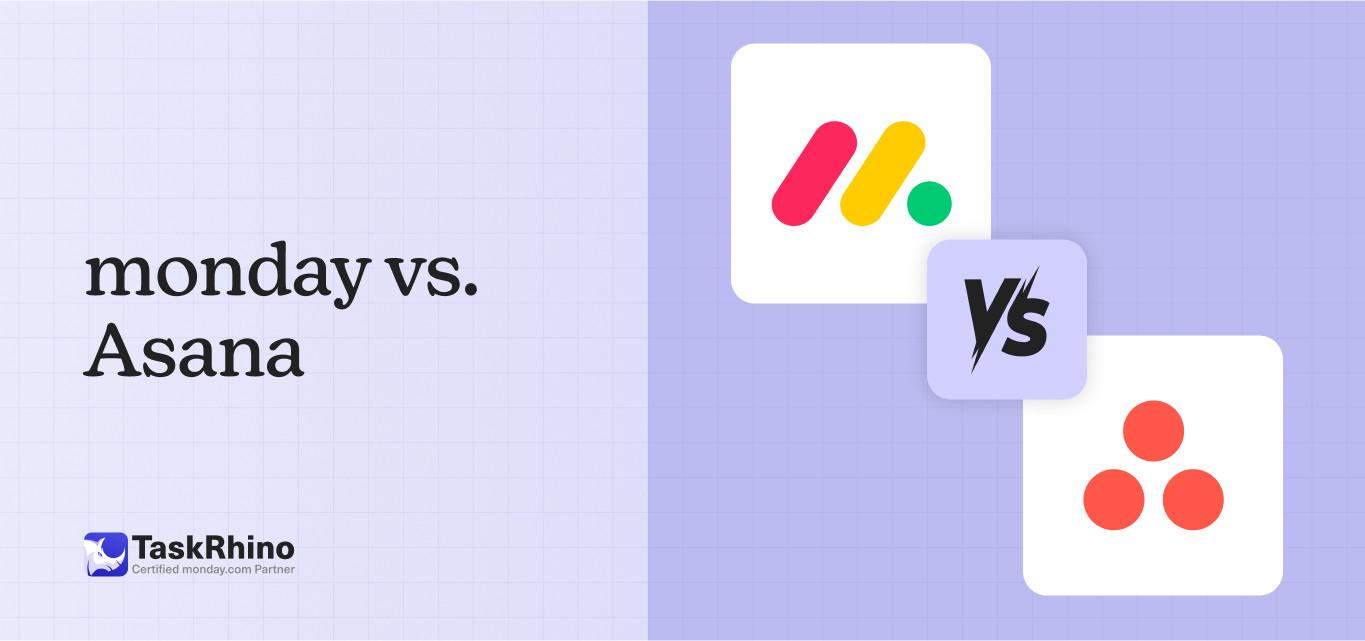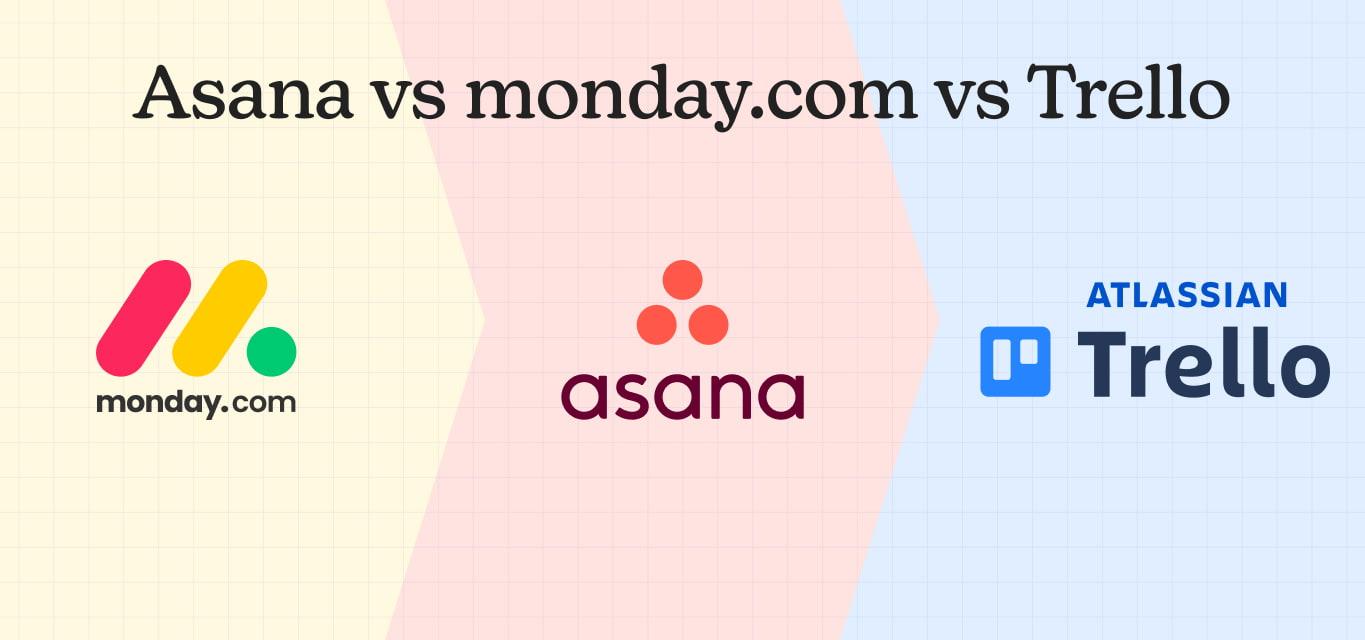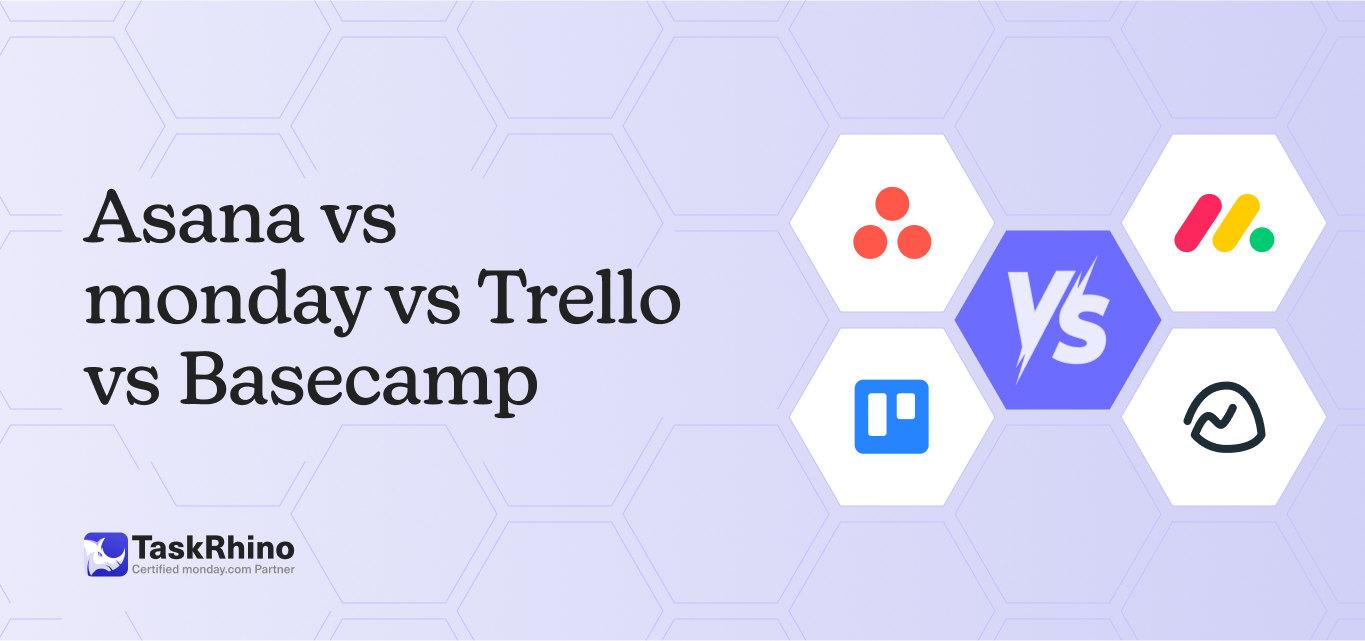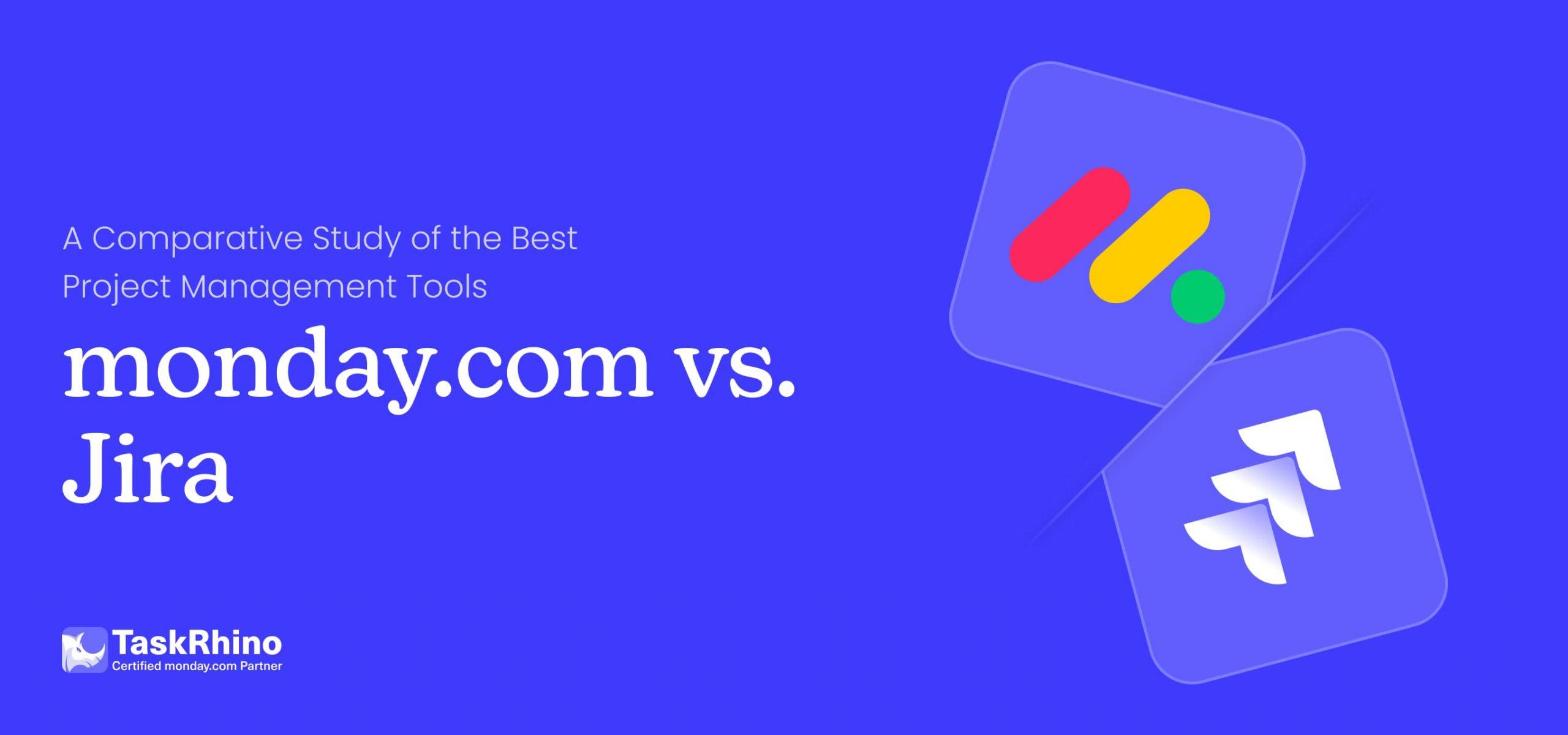
monday.com vs Asana 2025: Complete Feature & Pricing Comparison
Summary: This in-depth comparison of monday vs asana explores their features, pros and cons, and key elements such as task management, collaboration tools, and customization options. This analysis will help you pick which platform is the best fit for your project management needs.
What if you could turn your workday into a smooth experience where tasks get done easily and deadlines are met without stress?
With the right project management tool, this can be your reality, allowing you to focus on your work while keeping distractions at bay. Among the many project management tools available, Asana and monday.com are two standout options for multiple projects.
Asana offers powerful task management features that help teams managing tasks, and ongoing projects track their work, and collaborate effectively, while monday.com provides a user-friendly interface with customizable boards that adapt to various workflows.
In this blog, we’ll compare Asana vs monday, highlighting how each platform meets different needs. From tracking project progress with Gantt charts to using integrations that boost productivity, we’ll explore the strengths and weaknesses of both tools.
Additionally, we’ll discuss how monday.com consulting can help you maximize its benefits. Keep reading to find out which project management software fits your needs best.
How We Analyzed and Compared Both These Platforms?
Our analysis of Asana and monday.com is based on thorough research. We tested both project management platform, focusing on their features, user-friendliness, and pricing plans. We also considered user reviews and ratings from G2, Captera, and Reddit to gain insights into their overall performance.
A Quick Feature Comparison – monday vs Asana
When deciding which software is best for your team, a quick feature comparison provides the insights needed to make an informed decision. Here’s an overview of various aspects, such as usability, task and project management, collaboration, customization, integration, and pricing.
| Feature | ||
|---|---|---|
| Ease of Use | User-friendly layout with straightforward task management. Suitable for all tech levels. | Intuitive interface with customizable dashboards. Easy to learn for new users. |
| Task and Project Management | Focused on task categorization, milestones, and deadlines. Board and list views for tracking ongoing projects. | Offers multiple views (Kanban, Gantt, etc.) for managing projects. Strong task dependencies. |
| Collaboration | Offers team pages, direct messaging, and task comments for efficient collaboration. | Extensive tools for file sharing, commenting, and @mentions within tasks. |
| Customization and Flexibility | Custom fields and templates are available, but they are slightly less customizable than Asana. | Highly customizable workflows, fields, and automation. |
| Agile Methodology Support | Supports Kanban boards but lacks features specifically for Agile development | Kanban board and sprints support some aspects of Agile project management. |
| Integration and Automation | 200+ integrations with popular tools and automation options for routine tasks. | 200+ third-party app integrations and numerous automation recipes for managing tasks. |
| Security | Secure data encryption, user permissions, and compliance certifications for project data. | Secure data encryption, user permissions, and compliance certifications. |
| Customer Reviews | 4.7 out of 5 on G2 | 4.3 out of 5 on G2 |
| Pricing | Tiered pricing plans cater to different needs, from basic plans to advanced features. Paid plans start at $16/user/month. | Various pricing tiers, including a free plan for smaller teams and premium plans. Paid plans start at $24.99/user/month. |
| Try monday.com for Free |
Now that we’ve reviewed the quick comparison table highlighting the key aspects of both Asana and monday, it’s time to explore more about the core features that are essential for any project management software.
These essential functionalities—including task management, collaboration tools, and customizable workflows—are designed to optimize team productivity and streamline project progress.
Keep reading to explore how these key features are compared Asana and monday.com:
Core Feature Comparison to Decide The Right Project Management Tool
By comparing the essential functionalities of monday.com and Asana, you can make an informed decision that aligns with your team’s needs and workflow preferences.
Below the points discussed are considered from our research and real-world users:
1. Task and Project Management
 |  |
| Task Management: monday.com provides visual task management with customizable boards, making it easier to manage every single task quickly. Each task has detailed information like status indicators, priority levels, due dates, and team members to whom it is assigned. | Task Management: Asana has made it simpler to create detailed tasks with subtasks, descriptions, attachments, custom fields, and a comment section for updates. Once you create all the tasks, you can categorize them and move them into different sections or projects. |
| Project Visualization: Teams visualize projects using different views, such as Kanban, Gantt, and timeline charts, according to their preferences and needs. This can be particularly useful for tracking the progress of complex projects with many moving parts. | Project Visualization: There are different options for project visualization, such as board, calendar, and timeline views, that make it versatile for different project management styles. |
| Workflow Management: monday.com is mainly known for its ability to create and customize workflows with different integrations and automation that support a range of project types, from simple to complex. | Workflow Management: Asana mainly focuses on simplifying workflow management by making it simpler for your team to set up project templates and automate routine tasks with custom rules. |
| Deadline Tracking: Tracking deadlines with monday.com is much easier as it offers visual cues and automated notifications, helping you and your teams stay on top of the schedules. | Deadline Tracking: For tracking deadlines, Asana has a calendar view and timeline feature. Not only this, but it also has a dependencies feature, allowing you to set dependencies between tasks and highlight important paths in a project. |
2. Ease of Use
 |  |
| User Interface (UI): With its bright and colorful interface, monday.com wins the hearts of many users. They find it engaging and find it easier to highlight. Moreover, it uses a visually intuitive system of boards, which can be customized with different columns to fit any workflow. | User Interface (UI): Asana’s UI is quite clean, minimalistic, and simple, and it mainly focuses on clarity and ease of use. Centered around lists and tasks, the design made it easy to view in different forms, such as boards, timelines, or calendar views. With this, teams can easily manage projects in a way that suits them best. |
| Onboarding: With a guided onboarding process, monday.com stands out from Asana. Its tutorials and templates help new users use the tool effectively. It also offers a knowledge base and proactive customer support to assist new users further. | Onboarding: Asana has a straightforward onboarding experience with helpful prompts and an easy-to-follow setup process. All the new users can instantly learn the basics through Asana’s in-app guidance and tips. |
| Navigation: monday.com’s logical layout has impressed many users and made them navigate the tool straightforwardly. Some of the key project elements include boards, documents, and tasks that can be accessible from the main dashboard. | Navigation: The tool’s layout is user-friendly, making it easy for new users to find the information they need. It has been noted for its focus on tasks and clear organization of project information. |
| Support and Resources: monday.com offers a complete help center, webinars, videos, tutorials, and a community forum where users can easily learn and share experiences. In addition to this, customer support is also available for personalized assistance. | Support and Resources: Asana’s help center, which includes articles, guides, and video tutorials, helps new users find all the required information. Moreover, it has a community and forum for users to get advice and tips from other users. |
monday.com also has a WorkDocs feature, which helps teams reduce file-sharing.
3. Collaboration Features
 |  |
| Workflow Customization: Experience a high degree of customization options on monday.com. It allows you to create your own workflows from scratch and modify one of the many templates available. In fact, you can customize each workflow with a wide array of columns to manage different types of data and track metrics. | Workflow Customization: Asana’s workflow customization is perfect if you want to structure your work within its given framework. With its list-based approach, it’s easy to complete tasks and subtasks. Though it has board and calendar views, Asana has template options for various use cases and can be a quick way to set up a new project. |
| Automation: Monday.com’s automation capabilities make it easy for you to set up complex automations without any hassle. For instance, you can create an automation to assign tasks, send notifications, or move projects to different stages, considering different triggers or conditions without writing a single line of code. | Automation: Automation features like Rules help automate repetitive tasks within your workflow, saving you time and effort. Asana’s automation is generally considered less extensive than Monday.com’s. |
| Visualization and Reporting: There are different ways to visualize workflows with multiple views, such as Kanban, calendar, timeline, and Gantt chart. It offers dashboards to compile data from multiple boards for reporting and insights. | Visualization and Reporting: Asana provides a more limited but still effective set of visualization tools, such as its timeline feature, which is similar to a Gantt chart. Its reporting features are primarily focused on tasks and project status updates. |
Revolutionize Your Workflow with monday.com
Experience the future of work management with monday.com. Take control of your tasks, projects, and deadlines like never before.
4. Customization and Flexibility
 |  |
| Customization: If it is about customization, nothing is better than monday.com. It is a shining star if it is about customization. Users are allowed to create their own workflows from scratch or modify it with existing templates the way they want it. It also supports a variety of custom columns, such as text, numbers, dates, people, and even location fields. | Customization: Asana offers a clean and user-friendly way to organize tasks and projects. However, it doesn’t have as many customization options as monday.com, but it does provide flexibility with custom fields, sections, and tags to manage tasks. |
| Board Views: Multiple board views, such as Kanban, Gannt, timeline, calendar, and map view, can be easily customized to view your projects and tasks. | Board Views: Asana’s project views have lists, boards, and a calendar with a timeline view available on paid plans. These views can be customized to some extent to fit the team’s needs. |
| Automations: On monday.com, you will find a range of automation recipes. You can customize any recipe to automate specific actions within projects, reducing repetitive tasks and saving time. | Automations: In Asana, Auomations are known as “Rules” that help automate routine workflows to streamline project management. The complete suite of automation options is available only for premium and higher plans. |
| Integrations: With a number of integration options and third-party tools, your team is allowed to create a cohesive workflow that comprises other services they use. | Integrations: Asana can integrate with various applications, improving overall functionality. It’s mainly well-integrated with other tools used by agile teams. |
5. Integration and Automation
 |  |
| Integrations: monday.com offers a vast landscape of integrations, allowing you to connect with over 70 tools and apps directly and hundreds more through Zapier. You will experience seamless workflow across different platforms, such as email, CRM, communication tools, and more. | Integrations: Asana offers a strong selection of native integrations with leading apps, such as Slack, Google Calendar, and GitHub. Through Zapier and similar services, It can also connect to a wide range of additional tools, making it versatile and adaptable to various tech stacks. |
| Automations: The platform has extensive automation capabilities and a user-friendly interface that helps you create custom automation “recipes.” These recipes, which range from simple status updates to complex sequences of triggers and actions, reduce manual tasks and drastically streamline operations. | Automations: In Asana, these are known as “Rules”. You can automate routine tasks within the platform. Compared to monday.com, Asana has limited options, especially on the free plan. Asana’s automation is more about streamlining task management rather than complex, multi-step workflows. |
6. Portfolio Management
 |  |
| Visibility: monday.com offers highly customizable dashboards and portfolio views, giving project managers a clear overview of ongoing projects and task progress. This feature is particularly useful for tracking complicated workflows across multiple projects. | Visibility: Asana provides a Portfolio view to monitor project timelines, milestones, and task dependencies. It’s a practical tool for keeping track of day-to-day tasks and ensuring project progress across various teams. |
| Customization: monday.com allows users to tailor their portfolio management with custom fields, ensuring that task management fits their specific project needs. This flexibility is ideal for managing complex workflows and adapting to unique business operations. | Customization: Asana also offers custom fields, enabling teams to track project data and manage tasks, though monday.com offers slightly more premium features for creating personalized workflows and handling multiple projects. |
| Reporting: monday.com provides robust reporting and analytics tools within the portfolio feature, delivering insights into complete progress status, workload distribution, and task management. This makes it ideal for managing both small tasks and large, complex projects. | Reporting: Asana’s Portfolio view includes reporting tools that help monitor project timelines and task progress. However, monday.com’s reporting capabilities offer deeper insights. |
7. Workflow Management
 |  |
| Communication: monday.com allows users to integrate an in-platform messaging system, making it easy for them to communicate directly on task boards. Leave comments, tag colleagues, and share files within tasks or update everything becomes seamless with monday. | Communication: Asana relies on comment sections for communication. Users can comment on each task where team members can discuss details, provide updates, and ask questions, if any. |
| File Sharing: Upload and share files directly within tasks and keep all the necessary materials in one accessible location. | File Sharing: With Asana, you will experience file sharing through attachments from different sources, including computers, Dropbox, Box, and Google Drive. It makes it versatile in how files are brought together, shared, and organized. |
| Team Visibility: You will experience an excellent team visibility feature on monday.com. The platform offers a clear view of everyone’s tasks and responsibilities with different options to check team workloads. With this, you will get help in resource allocation and prevent burnout. | Team Visibility: Asana’s calendar and list views allow a team to check what others are working on. Under the Asana tool, “My Tasks” and “Inbox” help individuals stay informed about tasks assigned to them and updates relevant to their work. |
| Real-time Updates: Real-time updates and notifications make it easy for users to stay on the same page. They will instantly get updates on changes, comments, or completed tasks, boosting transparency and immediate feedback. | Real-time Updates: Asana’s notification system informs team members about new tasks, due dates, and updates. It also sends daily summaries to give an overview of the day’s agenda. |
8. Customer Support
 |  |
| Accessibility: monday.com has multiple support channels, including email, phone, and an extensive online knowledge base. It is popular for its responsive customer service team. | Accessibility: Asana’s support primarily operates through email and an online help section. They also offer an extensive help guide and community forums for user discussions and troubleshooting. |
| Resources: The team has a wealth of online resources, such as tutorials, webinars, and a community forum where users can ask different questions and share insights. | Resources: Asana Academy offers in-depth training and learning resources, including video tutorials and usage guides, helping users maximize their use of the platform. |
| Personalized Support: All customers get 24/7 support every day of the year, anytime, anywhere. | Priority Support: The higher-tier plans in Asana provide more dedicated support options, including priority support which ensures faster response times. |
When it comes to customer support, both platforms offer various options, but monday.com stands out with its 24/7 customer service and dedicated support team available on all plans, including the basic one.
Asana, on the other hand, provides support through its help center and community forums, though more direct assistance is reserved for premium users.
We recommend reading Asana Alternatives to know customer support well.
9. Security
 |  |
| Data Protection: monday.com ensures secure data encryption for all users, safeguarding project data across its platform. With compliance certifications like ISO and GDPR, it meets industry standards for data protection and privacy, giving organizations confidence in managing sensitive business operations. | Data Protection: Asana also employs secure data encryption and adheres to compliance certifications such as ISO and GDPR. While it offers strong security features, monday.com provides more advanced options for enterprises requiring additional layers of protection. |
| User Permissions: monday.com allows for granular control of user permissions, offering advanced features like private boards and restricted access to specific project management tools. This ensures that only authorized users can view or edit sensitive information, providing flexibility for managing teams and task dependencies securely. | User Permissions: Asana offers similar user permissions, allowing administrators to manage who has access to specific projects and tasks. However, monday.com provides more options for customizing access levels, especially useful for large teams managing complicated projects. |
| Enterprise-Level Security: monday.com’s Enterprise Plan includes added security measures like Single Sign-On (SSO), two-factor authentication (2FA), and audit logs to monitor project activities. This makes it an ideal choice for organizations with strict security requirements managing ongoing projects. | Enterprise-Level Security: Asana’s Enterprise Plan also includes SSO and 2FA, but its security features are slightly less customizable compared to monday.com. While secure, it may not offer as much flexibility for large enterprises with diverse security needs. |
10. Pricing and Plans
| Pricing Plans | ||
|---|---|---|
| Basic | $9 Price (per seat/month, billed annually) | Free Price (per seat/month, billed annually) |
| Standard/Premium | $12 Price (per seat/month, billed annually) | $10.99 Price (per seat/month, billed annually) |
| Pro/Business | $19 Price (per seat/month, billed annually) | $24.99 Price (per seat/month, billed annually) |
| Enterprise | Custom Pricing | Custom Pricing |
monday.com offers four premium pricing plans, including a free trial that lasts 14 days (no credit card required) to explore all its features. Users can start with the free plan and easily upgrade to a paid option, unlocking more up-to-date functionalities, including the enterprise plan for larger teams.
On the other hand, Asana presents four pricing tiers, featuring a free basic plan and two premium options, complemented by a 30-day free trial to test its robust capabilities.
If the pricing is more aligned towards economic choice, we recommend you check out our blog monday.com vs. Asana vs. ClickUp.
We found that monday.com often pulls ahead with its more comprehensive project management features, but it’s worth seeing how each tool measures up depending on your needs.
To cover more about both tools individually, we have got you covered – monday.com Review: In-Depth Look at Features, Pros & Pricing and Asana Review 2024: Features, Pros, Cons & Pricing Guide.
Asana vs. monday.com: Which Tool is Right For Your Organization?
If you are deciding whether Asana or Monday.com is the right tool for your organization or not, then ensure that it requires thoughtful consideration of your team’s specific needs, workflows, and the kind of projects you manage. Here’s the round of feature comparison so that you can quickly have a look and decide where to move ahead.
| Feature | ||
|---|---|---|
| Customization | ||
| Ease of Use | ||
| Project Complexity Handling | ||
| Task and Project Management | ||
| Collaboration and Communication | ||
| Integration and Automation | ||
| Pricing Flexibility | ||
| Learning Resources | ||
| Budgeting | ||
| Invoicing | ||
| Customer Support | ||
| Get Started with monday.com |
Thus, if you are looking for:
- A highly customizable platform with strong automations recipes and integration capabilities to handle complex projects
- A detailed approach to project management with extensive customization
- A vibrant and colorful display that can cheer anyone up
- An easy collaboration for the inter-departmental team to track tasks and projects
- An intuitive interface that makes it easier to use even for beginners
Then nothing beats monday.com, one of the leading Asana alternatives. To prove this, check G2 reviewers, who have rated monday.com better than Asana in terms of meeting business needs and having better ongoing product support.
If require a better understanding of how monday.com fits your business requirements and processes, then our professional monday.com consultant service is an ideal approach to move further.
Get More Done with Less Effort
Our experts help you maximize productivity and streamline workflows with ease.
Frequently Asked Questions
Can I migrate my data from Asana to monday.com easily?
Migrating data from Asana to monday.com is easy, and it mainly depends on the amount and complexity of your data. The platform offers export functions, and third-party tools and services are designed to facilitate this process. However, some manual adjustments might be required to ensure a smooth transition. Better to consult monday.com migration experts to help you with the process.
Which platform is better for managing complex projects with multiple teams?
Monday.com is often known for managing complex projects with multiple teams due to its extensive customization options, automation features, and advanced integrations that support complex workflows. monday.com is designed to adapt to different project types and scales, making it a strong choice for intricate project structures.
How do monday.com and Asana handle task automation?
Both monday.com and Asana offer task automation features to streamline workflows. On the other hand, monday.com provides a wide range of automation recipes that can be customized to suit various needs. Asana’s “Rules” feature offers automation within projects to reduce manual tasks. Monday.com’s automation is known for its in-depth options and flexibility, whereas Asana’s is praised for its ease of setup.
Can I integrate other tools and services with monday.com?
Yes, monday.com allows for extensive integration with other tools and services, enhancing its functionality. It supports direct integrations with popular apps like Slack, Google Drive, and many more. Additionally, through platforms like Zapier, users can connect Monday.com with hundreds of other apps to automate workflows across different tools.
What kind of customer support can I expect from monday.com and Asana?
monday.com offers support through various channels, including email and phone, and has an extensive knowledge base. The best thing about monday.com’s support is that it offers 24*7 customer support for all the customers, irrespective of their plan. Asana provides customer support mainly through email and its help center, with priority support available for premium users.
Editor's Choice

Asana vs monday vs Trello: Complete Comparison Guide 2025

Asana vs Monday vs Trello vs Basecamp: Complete 2025 Comparison Guide

monday vs Jira 2025: Complete Feature Comparison & Decision Guide
